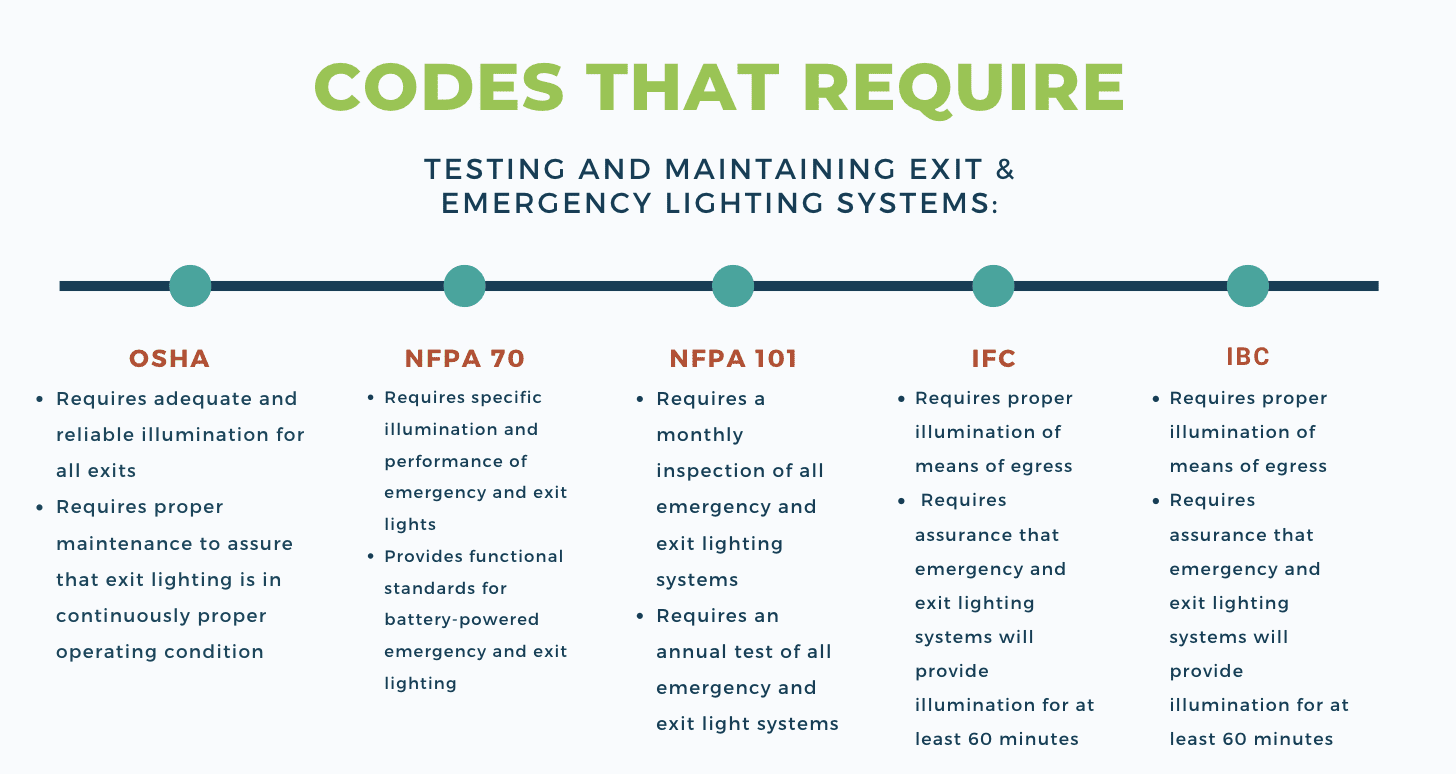Emergency Exit Light Inspections

Subscribe to our Blog
Emergency exit light inspections are a monthly and annual requirement by numerous building and safety codes. From OSHA to NFPA, the Joint Commission and the International Building and Fire Codes, these inspections are critical to the overall fire safety protection within the walls of your building. Ultimately, the property owners and managers are responsible for assuring that illuminated emergency exit signs and emergency lights are properly maintained.Occupants could be at risk if routine maintenance is neglected or is not performed by trained individuals with the correct tools, equipment, and replacement parts.
Before we dig a little deeper into the code requirements for these inspections, let’s talk a little bit about what emergency exit lighting is and it’s function.
What is Emergency Exit Lighting?
An emergency light is a battery-backed lighting device that switches on automatically when a building experiences a power outage or when a lighting circuit fails. Emergency lighting is mandated by federal and state building codes with the goal to achieve safety and security on the path of egress, in residential, commercial, and industrial areas. During an outage, primary lighting may go out, making it more difficult to navigate buildings. Maintaining emergency and exit lighting can be vital for helping occupants safely navigate to other areas or outside in these situations. It’s important for facility managers and maintenance personnel to understand the role of emergency and exit lighting and the importance of maintaining these units.
Why is Emergency Exit Lighting Needed?
Building environments are becoming increasingly more urbanized and intricate – with a corresponding rise in facility safety threats. This challenge is amplified when visitors aren’t familiar with a facility’s layout. In essence, emergency exit lighting is a lifeline. It enables the safe, prompt, and efficient evacuation of spaces and buildings in cases of blackout caused by power outage. An effective emergency lighting system also guides people in and around enclosed and open environments, as well as helps them locate safety equipment plus refuge and assembly points.
Path of egress refers to a continuous and unobstructed way to exit a building, structure, or space. Buildings or portions of buildings must be in accordance with building and safety codes. Paths of egress must have a sufficient amount of lighting and must be maintained and well-lit in the event of an emergency.
Effective emergency lighting is not only essential for ensuring the peace of mind of those responsible for the safe infrastructure of public and commercial buildings. It’s also a legal imperative in most countries enforced both by the authorities having jurisdiction. Emergency lighting is heavily governed and defined by product, application, and installation legislation standards covering occupational safety and building regulations.
Code Requirements for Emergency Exit Light Inspections
This chart below can be used as guideline in regards to common codes mandating these inspections. While code enforcement agencies or Authorities Having Jurisdiction (AHJs) may adopt the codes listed below or other codes they may enforce other editions. and may enforce other editions. Provisions of the various codes sometimes differ regarding similar sets of requirements. If you’ve chosen to perform these inspections in house or are using a contractor to perform the inspections, it’s important that inspectors verify the codes and editions enforced in your jurisdiction.

It’s important to note that the the most recent release of the 2018 edition of the National Fire Protection Association’s (NFPA), Life Safety Code® 101, became effective on September 6, 2017. The Life Safety Code® is updated every three years and provides strategies to offer greater protection from fire. Not all jurisdictions have accepted all requirements of NFPA’s Life Safety Code®. We can’t stress enough how important it is to determine which codes are required by your AHJ.
At the end of the day, these routine inspections are meant to ensure that the emergency and exit lights will work when required, they must be inspected, tested, and maintained. When it comes to emergency lighting equipment, there are a few common components that require inspection, testing and maintenance. Exit and emergency lighting all consist of a few main components: bulbs, main housing, and a backup power source such as batteries. A required 30-second monthly activation test and 30-minute annual power test of all these components will ensure that lights are able to operate for the full 30 minutes as required should a power outage or fire emergency happen in your facility. For additional information about emergency exit light inspections, check out our online course or contact us. We’re here to help!





